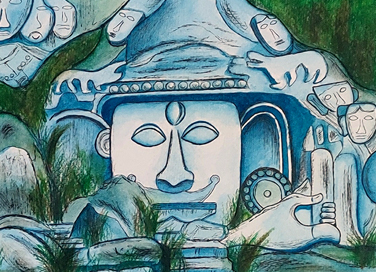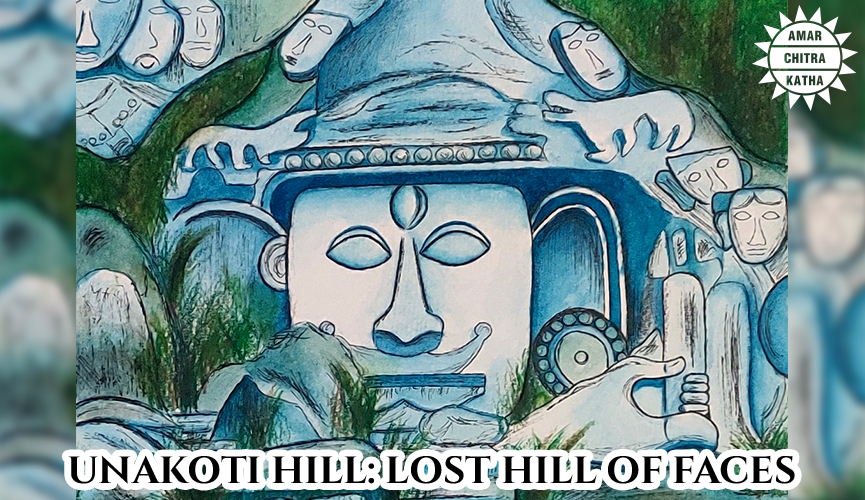Unakoti Hill: The Lost Hill of Faces
- April 29, 2021


Unakoti Hill: The Lost Hill of Faces
- April 29, 2021
Premium
By Vijita Mukherjee
The hilly state of Tripura, located in the North-eastern corner of India is home to a centuries-old Shaivite pilgrimage site, Unakoti. About 178 kilometres from the capital city of Agartala, this ‘Lost Hill of Faces’ or ‘Hall of Faces’ has India’s largest bas-relief sculptures tucked away in a dense forest.
The word ‘Unakoti’ means one less than a ‘koti’ or crore (ten million). Unakoti denotes the supposed number of these statutes that are scattered in this area, known as Raghunandan hills.
To receive more such stories in your Inbox & WhatsApp, Please share your Email and Mobile number.
As yet it has not been established who sculpted these massive statues or even exactly when the work began. However, there are many legends that exist about Unakoti and its creation. Here are some interesting ones:
Once one koti (or one crore) gods and goddesses including Lord Shiva were travelling from Kailash to Kashi. They stopped in this very place to rest for the night. It was decided that the next day, at the break of dawn they would all leave for Kashi. Shiva awoke much before sunrise and was ready at the appointed hour. However, much to his chagrin the other gods and goddesses had not moved at all and were fast asleep. Angered with this, Shiva cursed them to stay as still as stones and rocks and he left. And so they, the Unakoti, (one less than a koti or 99,99,999) remain there to this age.

As the darkest age of creation, Kaliyuga ascended, the gods and goddesses decided to leave earth as the conditions here would be too painful for them to endure. Shiva led them to the Raghunandan hills in Tripura, from where they departed to their heavenly abodes. While leaving, they left behind their imprints in the form of rock carvings and figures for those who live in this dark age to draw solace from. Shiva himself moved to Kailash after all the 99,99,999 immortals left for svargaloka.
Yet another legend links Unakoti to a talented sculptor named Kalu Kamar. Kalu wanted to make the place where he lived as holy as Kashi, the holiest of Shaiva pilgrimage cities. It was revealed to him in a dream that this could come true if he shaped one crore statues of gods and goddesses in one night. So Kalu set to work and tirelessly sculpted all of 99,99,999 statues. He then decided that he would make his own image as the last sculpture. That was his undoing. Since he had depicted one less than a koti or crore divine beings (not having himself reached a divine stature yet), his dream was shattered as dawn broke. Somewhere, there was a fine line between conceit and self-assurance which he crossed by depicting himself beside the gods as an equal. So Unakoti remained hidden in the dense forests and is only now coming to light for its artistic excellence.
Some others say that Unakoti is a site of Buddhist tantric practitioners. The almond-shaped eyes of the statues and the long ear lobes are reminiscent of Buddhist sculptures.
Whatever be the time and circumstances of the carving of these sculptures, the fact remains that these are unique both in execution and design. According to the Archaeological Survey of India, there may be more such sculptures awaiting discovery. Maybe one of those carvings will provide the historical inputs we lack about this mysterious place. Till then, we continue to look at this blend of folklore, religion and nature in wonder.
To receive more such stories in your Inbox & WhatsApp, Please share your Email and Mobile number.

Comic of The Month
The Naval Journey of India Book I
This book is the first of a three-book series that takes a deep and detailed look at India's Naval History and a deep insight into the lives of our men and women in white. But any series on the Indian Navy has to start at the very beginning - exploring India's celebrated maritime history. Join our little hero, Bharat, and his grandfather, Commodore Sagar, as they sail into the deep blue waters of time. Book I of The Naval Journey of India takes a sweeping look at India's maritime endeavours, how the seas impacted us over millennia and how the oceans made us who we are.